A LITTLE LOOK AT OUR CITY
Take advantage of the stay we offer to enjoy the beauty and history that the city of Benevento has to offer.
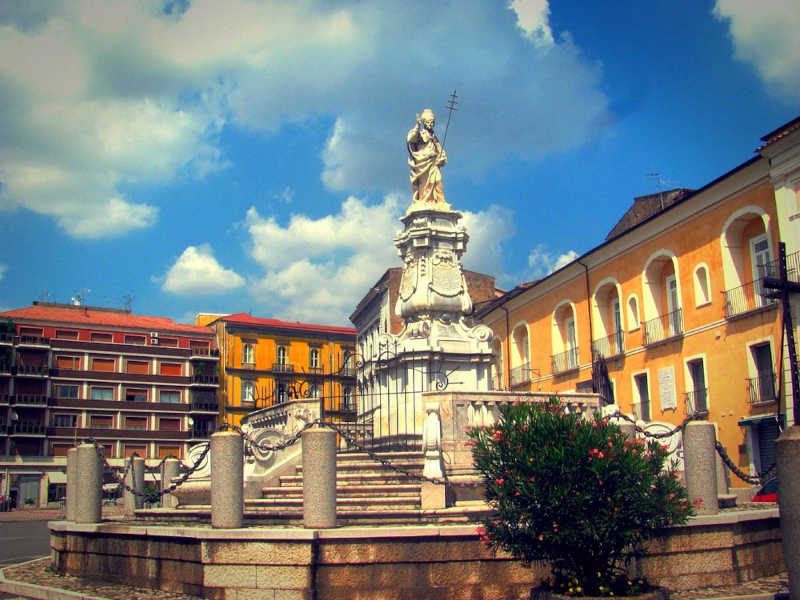
The historic center
A city rich in history and legends
The historic center of Benevento is the heart of the city that lives its stories, handing them down by genres. Of medieval origin, the historic center has been able to maintain the authentic beauty of the most fascinating and mysterious historical period.
A peculiar feature of the city are the narrow and dark alleys, which with their gloomy atmosphere perfectly reflect what are the legends and tales related to the witches of Benevento. The alleys are not the only point of interest, inside the center you can also find:
- Arch of Trajan (114 AD)
- Church of Saint Sophia
- Rocca dei Rettori
- Museum of Sannio
- Roman Theatre
- Monumental Complex of Sant'Ilario in Port'Aurea

The historic center
A city rich in history and legends
The historic center of Benevento is the heart of the city that lives its stories, handing them down by genres. Of medieval origin, the historic center has been able to maintain the authentic beauty of the most fascinating and mysterious historical period.
A peculiar feature of the city are the narrow and dark alleys, which with their gloomy atmosphere perfectly reflect what are the legends and tales related to the witches of Benevento. The alleys are not the only point of interest, inside the center you can also find:
- Arch of Trajan (114 AD)
- Church of Saint Sophia
- Rocca dei Rettori
- Museum of Sannio
- Roman Theatre
- Monumental Complex of Sant'Ilario in Port'Aurea
Arch of Trajan (114 AD)
A masterpiece of classical architecture
The Arch of Trajan is a unique work in the world. Symbol of Benevento, it represents a well-preserved testimony of Roman civilization. For its construction is indicated the date of 114 AD. It was built to celebrate the figure of Emperor Trajan on the occasion of the inauguration of the Appian Way, a road that connected Rome to Brindisi. Because of its size, it was called “Porta Aurea” over the centuries.
The rich sculptural decoration shows different themes on each façade: the inner one, which looks at the city and the citizens, addresses peace and providence while the external one that looks at the provinces refers to the war and the providences of the emperor. The attic has a central dedicatory inscription and two bas-relief panels: the external one contained two representations, the one on the left was a tribute to the rural deities while the one on the right the Deduction of provincial colonies. The panel on the inner side, also containing two representations, presented Trajan on the left welcomed by the Capitoline Triad and Trajan on the right in the Forum Boarium.
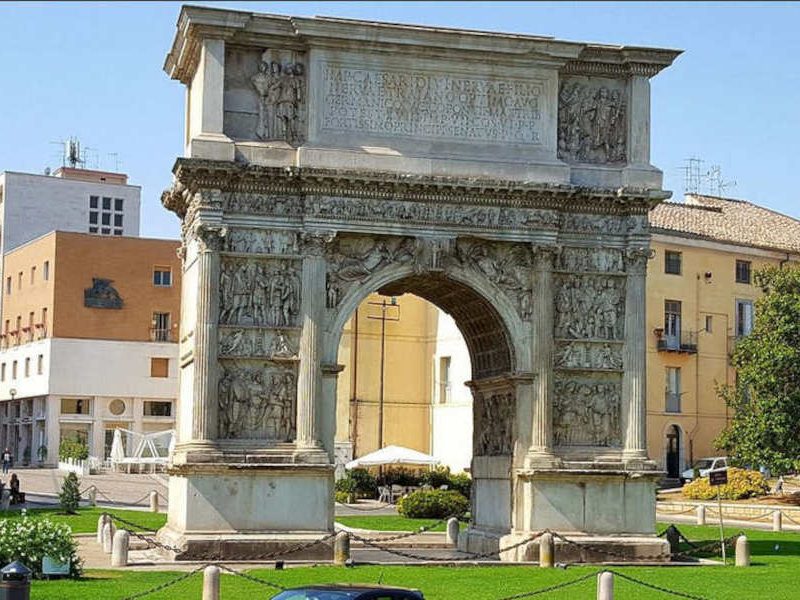
Arch of Trajan (114 AD)
A masterpiece of classical architecture
The Arch of Trajan is a unique work in the world. Symbol of Benevento, it represents a well-preserved testimony of Roman civilization. For its construction is indicated the date of 114 AD. It was built to celebrate the figure of Emperor Trajan on the occasion of the inauguration of the Appian Way, a road that connected Rome to Brindisi. Because of its size, it was called “Porta Aurea” over the centuries.
The rich sculptural decoration shows different themes on each façade: the inner one, which looks at the city and the citizens, addresses peace and providence while the external one that looks at the provinces refers to the war and the providences of the emperor. The attic has a central dedicatory inscription and two bas-relief panels: the external one contained two representations, the one on the left was a tribute to the rural deities while the one on the right the Deduction of provincial colonies. The panel on the inner side, also containing two representations, presented Trajan on the left welcomed by the Capitoline Triad and Trajan on the right in the Forum Boarium.

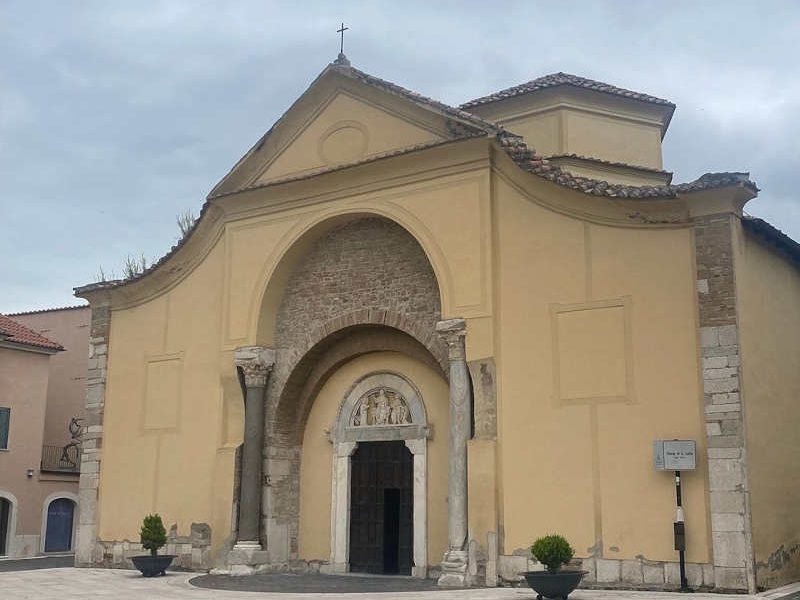
Church of Saint Sophia (758 AD)
Unique testimony of Lombard architecture
A few steps from the arch of Trajan there is another piece of Benevento that embellishes its historic center. The church of Santa Sofia is ready to tell its stories and legends.
It was the Lombard Duke Arechi II who in 758 AD asked to build it as a personal chapel and national sanctuary for the redemption of his soul and the salvation of the Lombard people. A monastery was annexed to the religious building, now home to the Museum of Sannio, with a cloister rebuilt in the Romanesque period, which reuses some original Lombard elements.
Its hexagonal plan and pillars create special plays of light and shadow at any time of the day. The bell tower, on the other hand, was built in the year one thousand, detached a few meters and positioned on the left side.
The interior of the church had to be completely frescoed. The frescoes of the apses represent one of the most important, but also the most controversial documents of Lombard painting in southern Italy.

Church of Saint Sophia (758 AD)
Unique testimony of Lombard architecture
A few steps from the arch of Trajan there is another piece of Benevento that embellishes its historic center. The church of Santa Sofia is ready to tell its stories and legends.
It was the Lombard Duke Arechi II who in 758 AD asked to build it as a personal chapel and national sanctuary for the redemption of his soul and the salvation of the Lombard people. A monastery was annexed to the religious building, now home to the Museum of Sannio, with a cloister rebuilt in the Romanesque period, which reuses some original Lombard elements.
Its hexagonal plan and pillars create special plays of light and shadow at any time of the day. The bell tower, on the other hand, was built in the year one thousand, detached a few meters and positioned on the left side.
The interior of the church had to be completely frescoed. The frescoes of the apses represent one of the most important, but also the most controversial documents of Lombard painting in southern Italy.
Rocca dei Rettori (871 AD)
Two architectures merge creating a unique style
The Rocca dei Rettori, also known as Castello di Benevento or Castello di Manfredi, is a castle located in the city of Benevento. With its imposing construction, which still wants to testify to the greatness of the Romans in fusion with the Lombard and Samnite populations, it boasts a unique architecture of its kind.
It was founded on the site of a previous Lombard fortified palace, built by Duke Arechi II starting from 871 in the place called “Piano di Corte”. The palace survived even after the end of the Duchy of Benevento, hosting over time several popes, the last of whom was Pope Gregory X in 1272, and later had been destroyed.
In 1321 Pope John XII of Avignon commissioned the papal rector of the city, Guglielmo de Balaeto, to build a fortified seat for the “Rectors”, which was to be built at the female Benedictine monastery of Santa Maria di Porta Somma, transferring the nuns to the monastery of San Pietro.
Inside you can visit the museum that collects historical testimonies of great interest, a way to learn about the events that led to the fortification of Benevento.
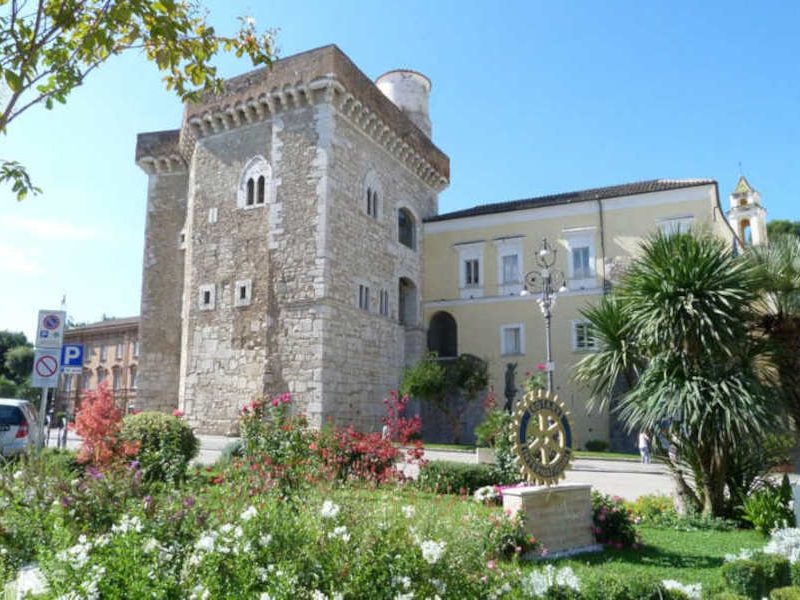
Rocca dei Rettori (871 AD)
Two architectures merge creating a unique style
The Rocca dei Rettori, also known as Castello di Benevento or Castello di Manfredi, is a castle located in the city of Benevento. With its imposing construction, which still wants to testify to the greatness of the Romans in fusion with the Lombard and Samnite populations, it boasts a unique architecture of its kind.
It was founded on the site of a previous Lombard fortified palace, built by Duke Arechi II starting from 871 in the place called “Piano di Corte”. The palace survived even after the end of the Duchy of Benevento, hosting over time several popes, the last of whom was Pope Gregory X in 1272, and later had been destroyed.
In 1321 Pope John XII of Avignon commissioned the papal rector of the city, Guglielmo de Balaeto, to build a fortified seat for the “Rectors”, which was to be built at the female Benedictine monastery of Santa Maria di Porta Somma, transferring the nuns to the monastery of San Pietro.
Inside you can visit the museum that collects historical testimonies of great interest, a way to learn about the events that led to the fortification of Benevento.

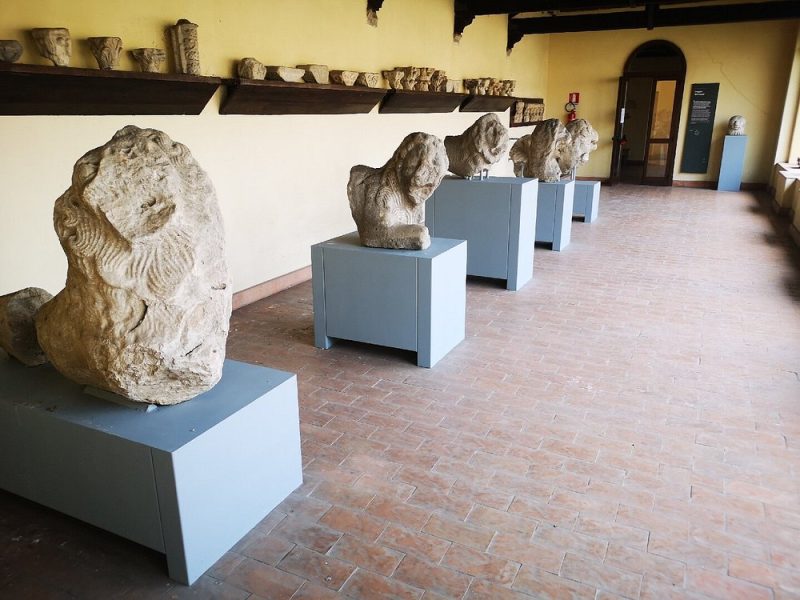
Museum of Sannio (1873)
One of the most varied museum collections
The museum collection is of the most varied, and represents a shining example of traditional territorial musealization, or a collection that has been built up over time, through a series of donations, purchases and assignments from all over the territory.
The museum collects historical testimonies that start from the Samnite and Roman period, passing through the Lombard age, then ranging from the ‘400 to ‘800, up to works by the most important artists of the national ‘900. The more than 50,000 exhibits cover a wide chronological span from prehistory to the present day, thanks to which it is possible to experience the construction of taste and awareness of cultural heritage over the centuries.
The route develops on the two floors of the monumental complex of Santa Sofia and in some rooms of the historic Palazzo Casiello, according to a chronological sequence. The Romanesque cloister of the twelfth century belongs to the museum nucleus which, together with the church of Santa Sofia, has been part of the UNESCO serial site “Longobards in Italy: the places of power” since 2011.
The exhibition includes:
- Sculptures and sarcophagi from the Roman age
- Library
- Conference room named after John the Virgin
- Egyptian Section

Museum of Sannio (1873)
One of the most varied museum collections
The museum collection is of the most varied, and represents a shining example of traditional territorial musealization, or a collection that has been built up over time, through a series of donations, purchases and assignments from all over the territory.
The museum collects historical testimonies that start from the Samnite and Roman period, passing through the Lombard age, then ranging from the ‘400 to ‘800, up to works by the most important artists of the national ‘900. The more than 50,000 exhibits cover a wide chronological span from prehistory to the present day, thanks to which it is possible to experience the construction of taste and awareness of cultural heritage over the centuries.
The route develops on the two floors of the monumental complex of Santa Sofia and in some rooms of the historic Palazzo Casiello, according to a chronological sequence. The Romanesque cloister of the twelfth century belongs to the museum nucleus which, together with the church of Santa Sofia, has been part of the UNESCO serial site “Longobards in Italy: the places of power” since 2011.
The exhibition includes:
- Sculptures and sarcophagi from the Roman age
- Library
- Conference room named after John the Virgin
- Egyptian Section
Roman Theatre
A piece of ancient Roman history
In the second century, during the reign of Emperor Hadrian, the Roman Theater of Benevento was built, inaugurated in 126 AD. With its grandiose diameter of 90 m, it could originally hold up to fifteen thousand people.
It was unearthed around 1920. It is among the ancient theaters, one of the best preserved and one of the largest and most beautiful. Outside, 25 arches on three orders (today only one has been preserved) gave access to the inner area, through stairs and corridors. The driveway was decorated with large masks, similar to those used by the theater makers of the time.
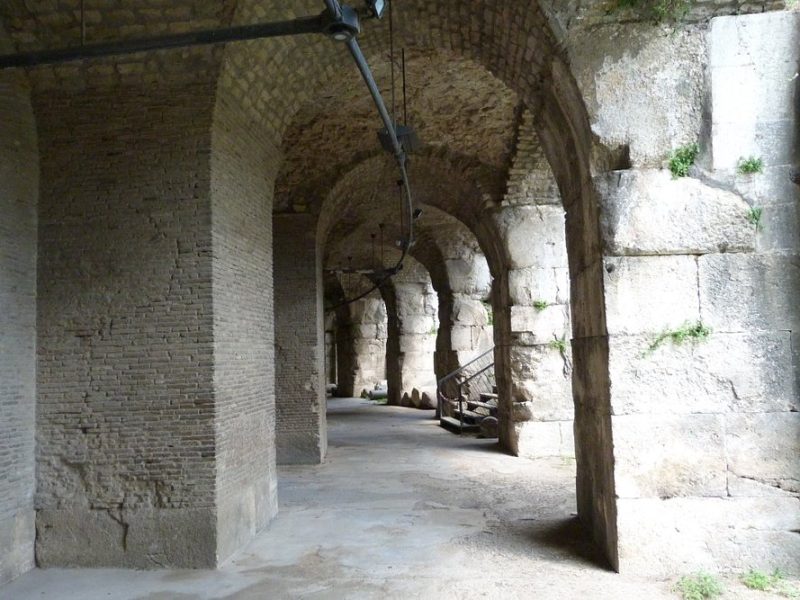
Roman Theatre
A piece of ancient Roman history
In the second century, during the reign of Emperor Hadrian, the Roman Theater of Benevento was built, inaugurated in 126 AD. With its grandiose diameter of 90 m, it could originally hold up to fifteen thousand people.
It was unearthed around 1920. It is among the ancient theaters, one of the best preserved and one of the largest and most beautiful. Outside, 25 arches on three orders (today only one has been preserved) gave access to the inner area, through stairs and corridors. The driveway was decorated with large masks, similar to those used by the theater makers of the time.

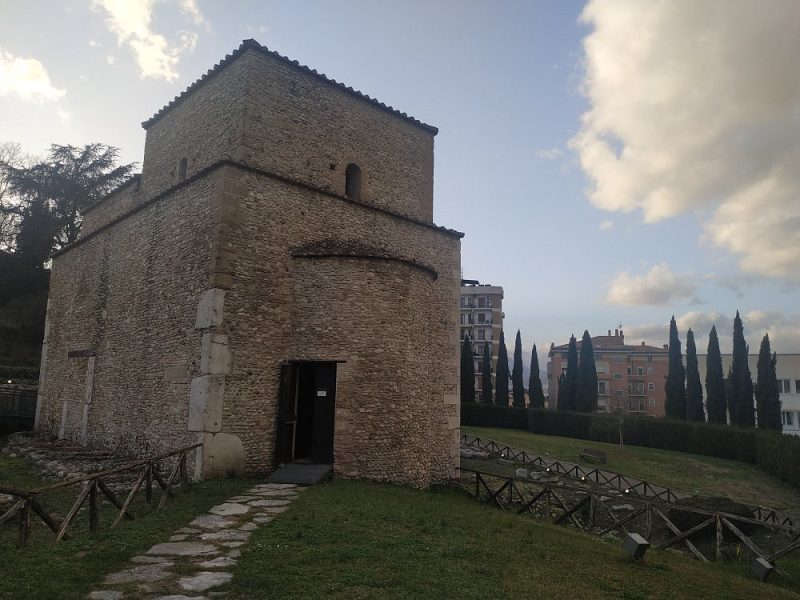
Monumental complex of Sant'Ilario in Port'Aurea (VI - VII century)
Testimony of Lombard architecture
The name of the complex, in the past used as a church, derives from the proximity to the Arch of Trajan, which in the Middle Ages, inserted in the walls, assumed the name of Porta Aurea.
A convent was then added to the church building, of which some remains are visible; Worthy of note are the cisterns and wells for water collection. The first document attesting to the presence of the church of Sant’Ilario and an adjoining monastery dates back to December 1148. Today, the monumental complex has been used as a Museum of the Arch of Trajan with the possibility of free use of a free guided tour of the archaeological park, and the former early medieval church.

Monumental complex of Sant'Ilario in Port'Aurea (VI - VII century)
Testimony of Lombard architecture
The name of the complex, in the past used as a church, derives from the proximity to the Arch of Trajan, which in the Middle Ages, inserted in the walls, assumed the name of Porta Aurea.
A convent was then added to the church building, of which some remains are visible; Worthy of note are the cisterns and wells for water collection. The first document attesting to the presence of the church of Sant’Ilario and an adjoining monastery dates back to December 1148. Today, the monumental complex has been used as a Museum of the Arch of Trajan with the possibility of free use of a free guided tour of the archaeological park, and the former early medieval church.







